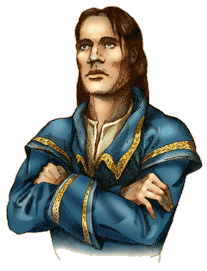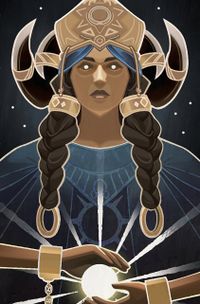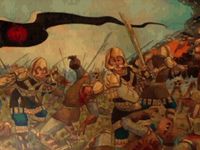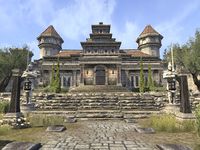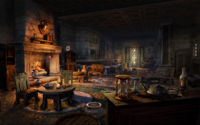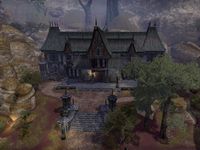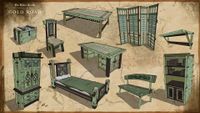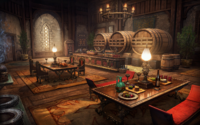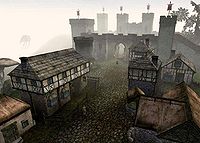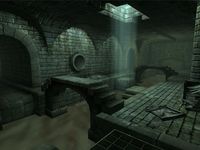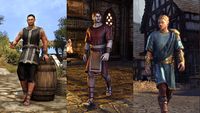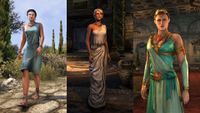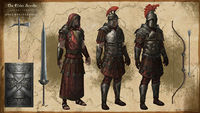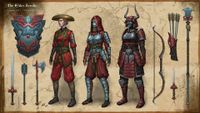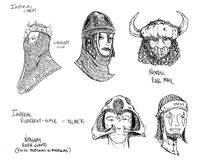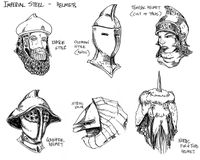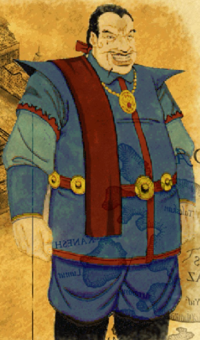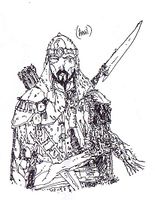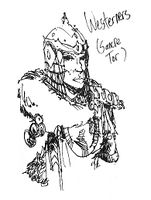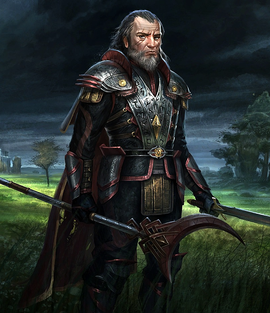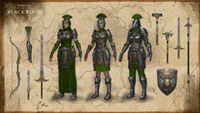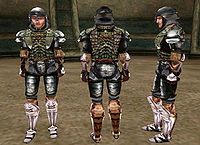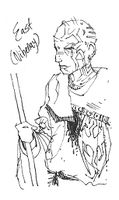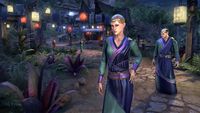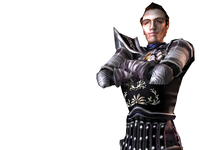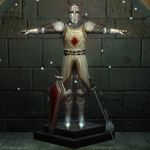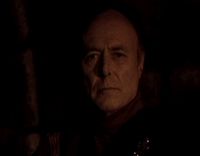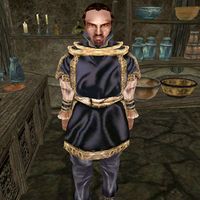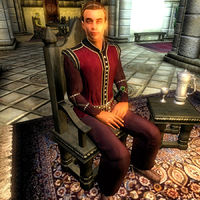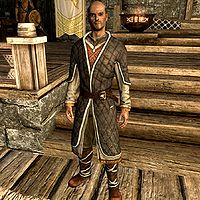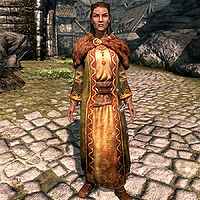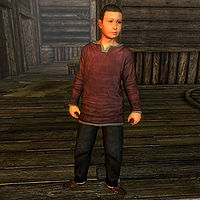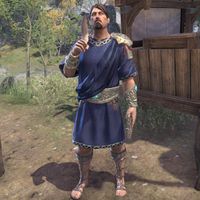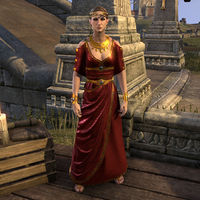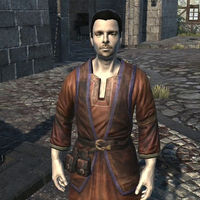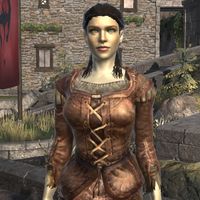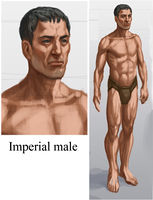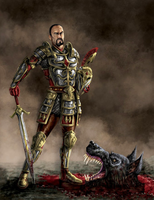Lore:Imperial
The Imperials, also known as Cyrodiils,[1] Cyrodilics,[2][3] and Imperial Cyrods,[4] are the well-educated and well-spoken natives of the civilized and cosmopolitan province of Cyrodiil. Imperials are also known for the discipline and training of their citizen armies, and their respect for the rule of law.[5] Imperials have proved to be shrewd diplomats and traders, and these traits, along with their remarkable skill and training as infantry, have enabled them to colonize various other nations and create the Empire.[6][7] Their hegemony has waxed and waned throughout the eras, and most historians refer to three distinct Empires, the ends of which each mark a new epoch in Tamrielic history.
Cyrodiil is a pretty blanket term for almost every element of the Imperial Province: the people are called the Cyrodiils, the land is called Cyrodiil, the capital city of their province is called Cyrodiil, and the ruler of the land no matter their race is called The Cyrodiil. this is derived from a king-is-the-land tradition that reaches back to when the Elves ruled the land.[1][8][9]
History
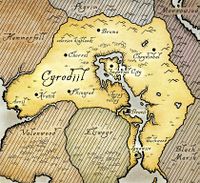
The Imperial race emerged out of the original Nibenese tribesman, Nedes and Cyro-Nords in the Merethic Era.[3][1][10] They were subjugated by a race of Aldmer, the Ayleids, but a rebellion against these rulers, formed under the guidance of Saint Alessia in 1E 242, would prove so successful that Ayleids were driven to extinction (though they left behind many treasures[11]).[3][1][12] The Alessian Empire united Imperials and pursued campaigns in other provinces, but when the Colovian west broke away, the resulting civil war in Cyrodiil ended the Empire.[1]
The eastern Nibenay Valley region and the western Colovian Estates developed distinct cultures, but still united under the Colovian Reman I to repel an Akaviri invasion in 1E 2703, creating the Second Empire.[3][1] The Akaviri had devastated many human lands, and Reman feared invasion from the Summerset Isle, so he allowed the remaining Akaviri to live and fight for him against the Elves.[1] Soon the Second Empire controlled every province of Tamriel except Morrowind.[1] The events surrounding the attempted conquest of Morrowind led to the end of the Reman emperors, and the First Era, in 1E 2920: the Akaviri Versidue-Shaie, who had earned a position as a trusted advisor, took control following the deaths of the Remans and the disastrous Four-Score War.[13]
The Akaviri Potentates would rule until 2E 430, but eventually assassinations and poor leadership would make the Empire crumble, leading to the Interregnum: for four hundred years, petty states all over Tamriel quarreled with each other, especially Cyrodiil.[3][14] The Imperial Province devolved into a collection of warlords squabbling over a no-man's land of cultural stagnation.[3][15] Eventually, it would take a Nord to reunite the Imperial Province: Tiber Septim was appointed general of the forces of Cuhlecain, a petty Colovian king. He routed all of Cuhlecain's enemies who would face him and his armies on the battlefield, quickly reuniting Cyrodiil. When Cuhlecain was assassinated in 2E 854, Tiber Septim assumed the throne.[1] In a few decades, the provinces would be reunited once more under his Third Empire, and this once-outsider to Cyrodiil had become the symbol of the whole realm.[3]
Ironically enough, most if not all of the Emperors of the Third Age would be Nordic or Breton, not Imperial. Following the cataclysms of the Oblivion Crisis, the leaderless Empire would once again begin to crumble, but it was an Imperial who seized the opportunity for glory: Titus Mede, a Colovian king, would seize the Imperial City with less than a thousand men and declared himself the new Emperor, though not much is yet known about this new dynasty.[16]
Culture
The defining feature of Imperial culture is its cosmopolitanism.[3] In an effort to make his home a cosmopolitan land, Reman I took elements from the Akaviri, Colovia, Nibenay, as well as from the distant province of High Rock, and incorporated it to a "common whole".[3] Although some individual Imperials may be the most arrogant bigots in Tamriel,[17][18][19] culturally the Imperials are very conciliatory and congenial, making them skilled diplomats and traders.[3] Even Imperial Vampires claim some semblance of civility.[20] It's easy to understand given their geography and cultural schisms: Cyrodiil borders almost every other province, and the historical separation yet underlying unity and interaction of the Cyrodilic regions made the Imperials well practiced at building bridges and maintaining order. Though there are many regions, the two most powerful effectively controlled all regions close to them: the western Colovian Estates and the eastern Nibenay Valley.
Early Imperials in eastern Cyrodiil strongly believed in the Alessian Doctrines, even after the Empire's fall, which made them disfavor many practices, notably farming.[1] They defaulted to mercantilism, and became a wealthy merchant power with a vibrant society that made colorful clothing, conducted elaborate ceremonies, and loved tattoos and philosophy.[1] Through their river network, they were able to export many goods, including textiles, fabrics, moon sugar, rice and armor.[1] Though their beliefs were monotheistic, they often focused on the numinous nature of some facet of society, and many diverse cults operated openly over the years, dedicated to many animal spirits and hero-gods, as well as ancestor worship.[1][21][22] The Colovians, in contrast, took on a more austere but adventuresome lifestyle, in keeping with their Nordic ancestry, and often became mercenaries and pirates.[1][21] The unification under Reman I didn't eradicate these differences, although, of course, the Eight Divines was predominant all over the province by the end of the First Era.[3][1]
The respect and admiration Imperials had for Tiber Septim is nothing compared to the veneration they have for him as a god of the Nine Divines, regardless of the heresies often espoused about him.[23][24] His accomplishments inspired them to believe they could do anything they set their mind to.[25] The end of his dynasty was greeted with great mourning, although also with great pride, as his last known descendant, Martin Septim, sacrificed himself to save all of Tamriel.[26] Imperials know all too well that dynasties are destined to rise and fall; all it will take is time before the Glorious Empire once again reigns over Tamriel.
Architecture
Many Imperial buildings were constructed from limestone.[27] The Nibenese city of Bruma is Nordic influenced, while Cheydinhal draws from Dunmeri inspiration.[28] The Imperial urban style, is a style of architecture that mixes with Dunmer urban style architecture in parts of the Hlaalu District and Vivec suburbs in Vvardenfell, it dominates in new Hlaalu and Imperial chartered towns. Houses, shops, and tradehouses are of timbered, with half-timbered, or stone construction, along with peaked roofs, right angles and flat planes, and plain, undecorated exteriors.[29] "Western Imperial Style" is an architectural style synonymous with villages throughout the western Empire. This Western Imperial Architecture is seen in places such as Pelagiad and Caldera, and if one were not knowledgeable of it, they can be easily mistaken for a city in High Rock.[30][31] Both Imperials and Bretons have influenced Redguard cosmopolitan architectural styles.[32] The Imperial City sewers have their own unique architecture design, with most of the Ayleid plumbing and sewage structure replaced by Imperial Civic architects to the point it isn't even Ayleid or recognized as such.[33]
Clothing, Armor, and Weapons
The Ancestor Moth is a rare indigenous gypsy-moth of Cyrodiil,[1] sacred to the Imperials. The Nibenese are known to use the ancestor silk of the gypsy-moth to craft exotic cloth, and export to others across the provinces. The singing and hymnal vocals of the ancestors are collected into a special silk-gathering ceremony, which is the ancestor silk. In the Nibenay, this silk harvest is a sacred tradition that dates back to their early history. But to the Cult of the Ancestor Moth, they are one of the same. The cult harvest the silk and undergo a magical ritual to enchant the fabric.[1] Ancestor silk shawls are a type of commodity made from the material, which are thought to hold memories of the dead.[34] Ancestor Silk can be fashioned into high quality light armor.[35]
Imperial River-Newt Scale,[UOL 1] is a Nibenese creation, hence it is also known as Nibenay River Guard. The armor type are considered exotic heirlooms within Morrowind.[UOL 2] Colovians are known for producing a variety of fur products, such as socks,[36] hoods,[37] or the well-known Colovian fur helmet (also known as the Colovian Arrow-Catcher).[UOL 3] The gladius is a weapon associated with Imperial culture.[38]
The Tsaesci left much influence on the race, and because of them, many Imperials can claim some Akaviri descent. Despite this, Akaviri surnames are rare and prized, while trace amounts of Akaviri facial features can be found among many important Cyrodiliic citizens. Colonies of "true Akaviri" (such as Hakoshae) exist in both the Empire and surrounding regions, named as such for keeping to their ancient traditions and customs and not by the purity of their blood.[1] The Tsaesci shared their weapon and armor making dubbed the "Serpentine Ways of Making" with the Imperials during the time of Reman, though this knowledge has been diluted or lost overtime.[39] Today, Imperials are still known to use Tsaesci-style equipment to some extent, especially daikatanas and river dragonscale armor.[1]
Through the Imperial Legion, Imperials and other races that serve within their organization can see equipment of high quality metal materials. The Legion's Blacksmiths can forge heavy armor from iron, steel, while some of their most skilled can create some dwarven, orcish, ebony or even daedric quality items.[40] The well-researched historical fiction 2920, The Last Year of the First Era claims that during the war between Morrowind and the Empire, the Imperial Legion used Daedric armor along with other high quality equipment.[41] Tiber Septim coveted the vast source of Ebony in Morrowind, leading to it being one of the main reasons for his decision to invade it.[24] Sometime after the signing of the Armistice, it was protected by Imperial law during the Third Empire, and could not be mined or exported without an Imperial charter.[42] The East Empire Company essentially became the sole authority to trade in raw ebony.[43]
Food
- Main Article: Imperial Cuisine
Imperial cooks approach food the same way they face the rest of life: in a straightforward and proud manner. As shrewd diplomats and traders, they stock their larders with many of the best ingredients Tamriel has to offer. Cyrodiil's central location in Tamriel, paired with its wealth and power, assures that the Imperials eat well from a variety of meats, vegetables, and spices from across the continent.[44]:11
Death
- Main Article: Imperial Death Beliefs
Imperials call Aetherius, the realm of the afterlife, Heaven. Imperial Theosophy teaches that Heaven is also the plane of pure magicka and the seat of the Divines and the other original spirits. Oblivion surrounds Mundus every night, but from Aetherius, energy infuses the daily existence, from highest to lowest, and gives all common purpose. Its magic "brings the rain to the fields, love to the hearts, and scientific principles to the technological industries". It gives the very Sun itself. Finally, Aetherius is the home to the Aedra, those cornerstones of the Mundus whose aspects are seen "in temple, in lordship, and the high walk of heroes".
Imperials bury all their dead, commonly underground both in graveyards, built in the interior of and vicinity of cities and towns; and also in catacombs below the chapels of the Churches of the Eight or the Nine, depending on the age. Gravestones dot the terrain of Imperial graveyards, signaling the location of the buried coffins where the dead rest. This is the most common form of entombment for commoners. On the other side, the nobility is commonly buried in crypts and catacombs, usually built outside of the cities and towns or below the temples of the Imperial cities. All these places are commonly guarded by Arkay's priests, who watch over the rest of the dead.
Imperial Subcultures
Colovians
The Colovians (also called the Western Imperials[45] or just the Westerners)[1] are the modern-day Imperials of Colovia. Their culture is influenced by their Nordic roots,[UOL 4] thanks to the Cyro-Nords that once settled in the region of Colovia. They possess the "frontier spirit" of their ancestors, leading them to inherit their simplicity, heartiness, and loyalty to their own. True to their name as Cyrodiil's iron hand, they are the strength of the Emperor, and make up the majority of the Ruby Ranks. The resolute people of the Colovian Estates managed to cause the collapse of the Alessian Order as a result of the War of Righteousness.[1] The Colovians tend to take on a more austere but adventuresome lifestyle in keeping with their Nordic ancestry, and often become mercenaries and pirates.[1][21] They can be distinguished from the Nibenese by their distinct accent.[46] Anvil, Chorrol, Skingrad, and Kvatch are notable Colovian cities.
The unification of the Cyrodiils under Reman I didn't eradicate the Colovians' differences with the Nibenese, although the Eight Divines were predominant all over the province by the end of the First Era,[3][1] and today, Colovians are known for their fierce devotion for the Divines.[47] They refer to "Shezarr" as "Shor" thanks to their Nordic influences.[21] The Akaviri Potentates were additionally referred to as the "Colovian Emperor-Potentates" and the "Colovian Dynasty," but the potentates' relationship to Colovia and the Colovians has not been explained.[48]
When it comes to clothing, the Colovians tend to dress with a simple or martial severity, unlike the Nibenese.[49] Colovian wear is visually distinctive of their frontier roots, as seen with the pointed helms and fur pelts worn by Sancre Tor highlanders,[50] or the armor worn by Colovians from County Anvil.[51] Colovian Prince's armor resembles traditional Imperial armor, but instead wore masked morion helmets.[52] Their sense of fashion, and even their taste have influenced other neighboring cultures, such as the Redguards of Elinhir.[53]
Nibenese
The Nibenese are the modern-day Imperials of Nibenay. They are said to be the closest thing to a pure-bred Nede, due to the ancient traditions that have survived through them,[54] and they are distant from their Nordic roots due to their ancestor's self-reliance, which separated them from Skyrim. They represent the high culture of Cyrodiil, showcased in their love for gaudy attire, philosophy, as well as their evolving ancient traditions. They are also known for their tapestries, tattoos, brandings, and elaborate ceremonies.[1] When a Nibenese tattoos themselves, its typically to identify one's religion, political faction, or their lifestyle.[55] Early Imperials in eastern Cyrodiil strongly believed in the Alessian Doctrines, even after the Empire's fall, which made them disfavor many practices, notably farming.[1] They defaulted to mercantilism, and became a wealthy merchant power through their river network. They were able to export many goods, including textiles, fabrics, moon sugar, rice and armor.[1] They are often focused on the numinous nature of some facet of society, and many diverse cults operated openly over the years, dedicated to many animal spirits and hero-gods, as well as ancestor worship.[1][21][22] Bravil, Bruma, Cheydinhal, and Leyawiin are notable Nibenese cities.
The Imperial Battlemages are the epitome of the Nibenese's inclination towards magic. "The Elven harassment of the First Empire" gave rise to the Imperial battlemages[1] as an elite unit separate from the Legions, founded during the early days of the Alessian Empire when the distinction between mage and warrior was more pronounced.[56] In time, the idea of a "battlemage" became less novel, and Imperial Battlemages began to serve alongside the regular Legions as spellcasters. Regulus Tharn was paramount in reviving the tradition of the Battlemage during the Reman Dynasty.[57] During this time, the Imperial Battlemages were further exalted with the creation of the "Imperial Battlemage" title, a prestigious position traditionally granted to a unit's leader.[56] For disambiguation purposes, the "Imperial Battlemage of Tamriel" is more distinct, and it represents an aristocrat who serves as head of the Elder Council, vs Imperial Battlemages which represent a cadre of war-caster troops.[56][58] Though the Imperial Battlemages were the ruling "mercantile-magocracy" of Nibeney, for a time, they were superseded by the Alessian priesthood who appealed to the common folk, but they would once again retake their place after the War of Righteousness. In the modern day, Imperial Battlemages make up a Nibenean age-old aristocracy, and alongside religious organizations and the merchant-nobility, they are above the workers plying the fields on the social hierarchy.[1]
The "Heartlanders" are a subsect of the Nibenese. These inhabitants of the Heartlands region of Cyrodiil are secularists that are tolerant with religion, and see it as both a personal and a private matter, leading them to believe the rule of the Alessian Order as a dark age. They do not speak directly to their gods, and do not see their everyday actions as constantly survived by them.[59] The Imperial City lies in the Heartlands, and the architecture is Nibenese, except for the walls and the White Gold Tower, which are Ayleid.[4]
Rim-Men
The Rim-Men (also known as the Rimmen)[60] are a group of Imperials that live across the Rim Territories in the province of Elsweyr. The Rim-Men descended from Imperial retainers that worked and later intermingled with the Tsaesci that served the Second Empire of Cyrodiil. These refugees fled the Imperial City following the death of Savirien-Chorak in 2E 431 and the ascension of the warlord Attrebus during the Interregnum.[60] They live in isolation from the rest of Elsweyr and practice the culture that comes from their ancestral homeland of Akavir[61] such as the Proving Festival or the belief that waterways connect to the realm of the dead.[62]
Empires
Major portions of Imperial culture and identity involves the various Empires throughout their history.
Alessian Empire
The Alessian Empire, also called the First Empire,[63] the Empire of Cyrodiil,[64][65] and the Empire of Men,[66] was established by the former human slaves of the Ayleid Empire in 1E 243 following the Alessian Slave Rebellion.[67] The Empire traces its founding to the moment when Saint Alessia received the Dragonfires and the Amulet of Kings from Akatosh; she used the Amulet to drive the Daedra out of the mortal realm.[68] Akatosh told Alessia that as long as the Dragonfires remained lit and her heirs wore the Amulet of Kings, the gates of Oblivion would remain shut and Tamriel would be spared the depredations of the Daedra.[68]
- See the main article: Alessian Empire
Second Empire
The Second Empire, also known as the Cyrodilic Empire[1], the Empire of Cyrodiil,[69] and the Second Empire of Men,[1] was a human-led empire that, at its height, controlled every region of Tamriel with the exception of Morrowind.[1] The history of the Second Empire is divided into two main periods: the reign of the Reman Dynasty that witnessed the final centuries of the First Era, and the subsequent Akaviri Potentate that ushered in the Second Era.
- See the main article: Second Empire
Empire of Cyrodiil
The Empire of Cyrodiil[70][71] (also known as the Imperial Empire[72]) refers to an Imperial state that existed during the early years of the Interregnum. Although identified as an empire, it differed from the Alessian Empire, Second Empire, and Third Empire in that its only permanent dependency was Cyrodiil itself, and it was at no time ruled by a Dragonborn emperor.
- See the main article: Empire of Cyrodiil
Third Empire
The Third Empire (also called the Holy Cyrodiilic Empire of Tamriel[73]) was declared by Tiber Septim in 2E 854 after the chaos of the Interregnum, and was forged through a decades-long conflict to unite Tamriel known as the Tiber War.[1] It lasted throughout the whole of the Third Era and two centuries into the Fourth Era, when it began to decline.
- See the main article: Third Empire
Imperial Institutions
Battlespire
The Battlespire, also called the Spire or the Celestial Citadel, is a void-castle that serves as the magical war academy of the Imperial Battle College and Imperial Battlemages, acting as a testing facility for those seeking to join the Imperial Guard. The strongest mages in the Empire reside and train in the Battlespire. It is described as the fortress of all fortresses that encompasses the entirety of a realm, with ramparts that tower over the edges of Oblivion. Beyond them, only the Void. The Imperial Battlemage of Tamriel (not to be confused with regular Imperial Battlemages) is an aristocratic position in which one serves as the advisory head of the Elder Council, and it was customary for future advisors to be plucked from the administers of Battlespire, the Spire Council, who were themselves battlemage classmen.
Elder Council
The Elder Council, also called the Imperial Council, and the Imperial Council of Elders, is the foremost administrative body in the Cyrodilic government. The Council's actions are governed by the rules and procedures outlined in the Elder Council Charter. It typically convenes at the Elder Council Chamber in the lower floors of the Imperial Palace in the Imperial City. The leader of the Elder Council holds the title of High Chancellor, and a Chief Councilor is designated as his deputy.
Though it theoretically merely helps the Emperor govern by dealing with various details, the Council has proven capable of wrestling a substantial amount of authority away from the Imperial throne, and there is often a power struggle between the two. The Council has legislative authority, and may vote on and enact new laws they deem proper. However, the reigning Emperor retains the power of veto, a right famously exploited by Uriel Septim VI to restore the power of the Emperor when faced with an unruly Council.
When the Council is not in some sort of disagreement with an Emperor, its members are often looking for ways to curry favor with the Ruby Throne. Each member receives an amulet worth a small fortune which is specially crafted as a symbol of their office. As a prominent family in Cyrodiil garners more and more power and repute, people eventually start thinking it is only a matter of time before they obtain a representative on the Council, though it is not clear exactly how new Council members are appointed. Appointment is seen as both an honor and burden, though some nobles view it only as a means to obtain more power and influence.
Imperial Legion
The Imperial Legion, also known as the Imperial Army, Dragon-Tribe of the Emperor, the Red Legions, and the Ruby Ranks, is the main fighting force of the Empire of Tamriel. It is often pluralized as the Imperial Legions. Headquartered in the Imperial City Prison, they operate under the auspices and authority of the Emperor himself. With its vast numbers, quality training, and rigid discipline, the Legion is considered one of the best armies ever assembled in history. The primary mission of the Imperial Legion is to preserve the peace and rule of law in the Empire. Those who protect the Emperor and the Imperial Province are sometimes called the Imperial Guard and the Imperial Watch. A Legion Centurion is typically in command of the Palace Guard of the White Gold Tower. The Legion's administration is known as the Imperial War Office.
In peacetime, the Legion serves primarily as a garrison force — manning forts, patrolling roads, and providing guardsmen for towns, cities, counties, and nobles. They are empowered to arrest criminals and seize their property, among other things. In wartime, the Legion's responsibilities and powers are greatly increased. During conflicts, the Legion serves as an invading and occupying force, overwhelming opposition with numerical superiority and strict economy of force. Legionnaires serve under an Imperial contract and, for its duration, they can be reassigned to different postings or even subcontracted to serve in local guard forces, at the discretion of the superior officers who have the authority to reassign them. The aquatic equivalent of the Imperial Legion is the Imperial Navy, with the two often overlapping.
For more information, see the main lore article.
Imperial Mananauts
The Royal Imperial Mananauts of the Elder Council were a largely unknown group who were known to travel to Aetherius. They were believed to be a holdover from the days of the Reman Dynasty.[74][UOL 5]
During the reign of Emperor Reman, the Imperials came up with a plan to colonize the moons Masser and Secunda, and started building the Megalomoth vessel-fortress NVN Manywife for this purpose. However, Reman did not live long enough to see the vessel's completion, and it was rechristened the NVN Accrual by Emperor Reman II, who personally oversaw the first lunar landing of the moon Secunda.[UOL 6]
University of Gwylim
The University of Gwylim (also called the University of Gwilym or Gwylim University) is an ancient scholarly organization dating back to the late First Era, and was founded by the Ayleid scholar Tjurhane Fyrre. The University of Gwylim Press has been responsible for many publications throughout history. It is known that the university awards the Gwylim Prize to scholars at times.
The University of Gwylim itself is found in Cyrodiil. Phrastus of Elinhir originally taught at the university before being forced to flee to Elinhir due to the Three Banners War. There is a forbidden section of Gwylim University containing books, and it is unknown what else it carries. They have a satellite campus called the Gwylim Annex in Solitude.
Religion
Imperial Religion primary focuses on the Eight Divines, or the Eight and One which includes the ascended Talos.[75][76] The Imperials have a lot of cults dedicated to various religions with the Imperial City.[77][1][21] Despite this, the Imperials have a history of restricting and banning the worship of deities that are not of the traditional Eight Divines. The study of these other gods was encouraged though. During the First Empire, the Imperials were strictly forbidden from worshiping or idolizing the deities Magnus, Y'ffre, Sheor, and Phynaster and worship of these deities was considered heresy.[78]
| |||||||||||||||||||||||
Divines
The Eight and One
- Arkay, the Mortals' God
- God of cycles, particularly that of birth and death. Presides over funerals and burial rites, as well as ushering in the changes of the seasons.[23]
- Dibella
- Goddess of beauty and art, and one of the most popular of the Divines. Widespread cults are dedicated to both healing and sexual instruction.[23]
- Julianos
- God of logic, wisdom, and the arts of magic. His temples act as educational institutions in literature, history, and law.[23]
- Kynareth
- Goddess of the heavens, winds, and rain. Patron of sailors and travelers, and often propitiated for good fortune in life.[23]
- Mara, the Mother-Goddess
- Goddess of love, compassion, and the bounty of nature. Presides over marriage ceremonies, befitting her ancient origins as a fertility goddess.[23]
- Stendarr, the Steadfast
- God of mercy, justice, and righteousness. Patron of all those who wield righteous might to protect the weak, from emperors to holy warriors. [23]
- Zenithar, the Trader God
- God of work, commerce, and wealth, invoked for success in business ventures. Teaches prosperity through honest industry, rather than violence or deceit.[23]
- Talos/Tiber Septim
- A mortal and emperor who upon death became a divine, the respect and admiration Imperials had for Tiber Septim is nothing compared to the veneration they have for him as a god of the Nine Divines, regardless of the heresies often espoused about him.[23][24] His accomplishments inspired them to believe they could do anything they set their mind to.[25] The end of his dynasty was greeted with great mourning, although also with great pride, as his last known descendant, Martin Septim, sacrificed himself to save all of Tamriel.[26] Imperials know all too well that dynasties are destined to rise and fall; all it will take is time before the Glorious Empire once again reigns over Tamriel.
Other Deities
- Reman, The Cyrodiil
- Culture god-hero of the Second Empire, Reman was the greatest hero of the Akaviri Trouble. Indeed, he convinced the invaders to help him build his own empire, and conquered all of Tamriel except for Morrowind. He instituted the rites of becoming Emperor, which included the ritual geas to the Amulet of Kings, a soul gem of immense power. Also called the Worldly God and called a conqueror god along with Talos.[23]
- Morihaus, First Breath of Man
- Ancient cultural hero god of the Cyro-Nordics. Legend portrays him as the Taker of the Citadel, an act of mythic times that established Human control over the Valley Heartland. He is often associated with the Nordic powers of thu'um, and therefore with Kynareth.[79][21][23]
- Shezarr, God of Man
- Shezarr is the spirit behind all human undertaking, particularly against Aldmeri aggression. Original depictions of Shezarr from early Cyro-Nordic tellings made him out to be a warlord who fought against the Ayleids, and opposed Aldmer. Following Alessia's victory against her Ayleid oppressors, Shezarr's worship was changed to its modern version as a watered-down version of Shor as an attempt to appease Alessia's elven pantheon worshiping subjects as well as her Nordic allies. By the end of the Third Era, worship of Shezarr had all but stopped due to increased racial tolerance.[23][21]
Saints
The Imperial Saints are pious individuals venerated by the Church, the majority religion among Imperials. Devotions are often made to them as a group, known collectively as the Communion of Saints.
Many saints are historical figures who continue to be revered long after death. The Church also venerates Living Saints, individuals who have received a calling to live by the commands of their chosen Divine as an example to others. It is believed that saints are blessed by the Divines with a second sight and that they do not view the world as other mortals do. Saints are buried in the graves of Green Emperor Way among other important figures in the Empire.
The practice of saint-eating was popular in the First Era before it was banned at some point prior to 1E 2877. This involved the disinterring of a saint's body for use as an ingredient in the preparation of food. However, apocryphal accounts suggest the practice did not immediately cease. An ancient text called the "Scroll of Precursor Saints" was supposedly discovered by Abnur Tharn in the vaults of the White-Gold Tower in 2E 541.
Daedra
To HIRCINE who is Half the Conscience of Men.
To MALACATH who speaks all Language Sideways.
To MEHRUNES DAGON whose Mistress is the Blazing Sun.
To MOLAG BAL whose Breath is Most Foul.
To NAMIRA whose Works endure forever.—Excerpt from the 16 Acceptable Blasphemies[nb 1]
The Imperials generally have a negative view of Daedra, with notable differences between the behavior of Colovians and the Nibenesse during the Interregnum. As Colovians are especially religious, they will typically refuse to associate themselves with Daedra.[80] During this period, however, the Nibenese were more inclined to turn to Daedra worship.[81] In Tiber Septim's empire, the Daedric Princes were invoked as the 16 Acceptable Blasphemies.[82]
The Imperial's distaste for Daedra was readily apparent during the reign of the Longhouse Emperors, a short-lived Reachfolk Dynasty that was brought to an end after Emperor Leovic legalized Daedra worship (allegedly at the behest of corrupt advisors). Leovic consequently drew the ire of many nobles who had once been counted among his supporters.[83] One of these erstwhile supporters, Duke Varen Aquilarios of Chorrol, marshaled the armies of the Colovian Estates and led them against Leovic in open rebellion from 2E 576 to 2E 577.[84] In the end, Varen killed Leovic in the Imperial Throne Room, and the reign of the Longhouse Emperors came to a close.[85][86]
House Tharn of Nibenay has always kept ties with the forces of Oblivion.[87] During Emperor Varen's reign, Abnur Tharn unwittingly helped Mannimarco cause the Soulburst, and subsequently pledged his loyalty to the necromancer (and by extension, Molag Bal) in the interest of preserving the Empire.[88][89] Unlike Abnur Tharn, several other members of the family had aligned themselves with Molag Bal wholesale: Abnur's nephew Javad was a prominent figure in the Stonefire Cult (an offshoot of Mannimarco's Worm Cult),[80] and Septima Tharn led the Seventh Legion in the Daedric Prince's name.[90][91][92][93]
The Tharn family's dealings with Molag Bal was the primary motivator for the Daggerfall Covenant, Aldmeri Dominion and Ebonheart Pact's invasion of Cyrodiil. At first, their goal was to depose the Tharn family, but the conflict devolved into the Alliance War.[94] To his credit, Abnur Tharn joined the Five Companions in their quest to end the Planemeld.[89]
Despite the Imperial distaste for Daedra worship, it is not banned in Cyrodiil, due in part to the Imperial Charter that permits the Mages Guild to summon Daedra. However, the opinion of religious institutions and the general public is hostile, a fact that encourages Daedra worshippers to practice in secret. Some even build their shrines out in the wilderness, where they may be attended by a community of faithful in peace.[22]
Artifacts
Amulet of Kings
The Amulet of Kings, also called the Amulet of the Kings of Glory, was a pendant traditionally worn by the ruling emperor of Cyrodiil. Set in its center was the Chim-el Adabal, also known as the Red Diamond, a huge soul gem of Ayleid origin. It was held in a golden clasp surrounded by eight smaller gems that represented the Eight Divines of the original Cyrodilic pantheon, created by Queen Alessia. It served as the symbol of the divine right of the Cyrodilic emperors. The amulet was an important component of the coronation ceremony and a powerful artifact when used for divination. The soul of each reigning emperor was enshrined within the central stone, presumably during the coronation ritual involving the Dragonfires and the divine Covenant. In this way Cyrodiil's rulers were brought together in death, forming an 'oversoul' that could provide counsel to their successors. The amulet could only be worn by certain individuals—those who could wear it were said to have the 'Dragon Blood' in their veins. The specific requirements, however, have been a subject of debate, and they may simply have called for the attributes of a ruler or some divine mandate.
The Amulet of Kings is a sacred symbol of the Empire, although most people think of the Red Dragon Crown as the Empire's main symbol of power. The Red Diamond has also become a symbol heavily associated with Imperials.
Boots of the Apostle
The Boots of the Apostle are very mysterious. The wearer of the boots is rumored to be able to levitate, though sightings of them in use have been extremely rare. The Greybeards supposedly gave Tiber Septim the boots after he had learned their secrets from them, as a reward for his "cunning craft and riddling". They are now considered relics of Tiber Septim and are legendary treasures of Cyrodiil.
Crusader's Relics
The Crusader's Relics are a set of Aedric artifacts, created by the Eight Divines and given to Pelinal Whitestrake, the Divine Crusader. The set includes a suit of armor, a shield, a mace and a longsword, which mold to the needs of the wielder and increase their proficiency in the School of Restoration. The artifacts were used by Whitestrake to banish Umaril the Unfeathered, an Ayleid Sorcerer King. In the battle, Umaril had dealt him a fatal blow, and with his death the relics were scattered and lost for a time. The contemporary writings contained within The Song of Pelinal mention that the Crusader's Relics came from the future.
Lord's Mail
The Lord's Mail (also called the Armor of Morihaus or the Gift of Kynareth) is an artifact given to mortals by Kynareth, one of the Eight Divines. It is an ancient plated adamantium or mithril cuirass of unsurpassable quality, considered to be heavy armor. It grants the wearer the power to absorb or regenerate health, resist the effects of spells, and resist or even cure poison. It is said that whenever Kynareth deigns the wearer unworthy, the Lord's Mail will be taken away and hidden for the next chosen one. The Mail was originally owned during the Merethic Era by the bull Morihaus, a demigod and early cultural hero of the Cyro-Nordics who was closely associated with Kynareth and the Lord. The cuirass was rumored to have later been taken from Morihaus by Kynareth herself due to his arrogance. The cuirass is considered an Imperial relic, and is accepted as a uniform in the Imperial Legion. Indeed, the armor has been known to bear the red dragon sigil of the Third Empire on its breastplate.
Gallery
Appearances
Miscellaneous
Notes
- Common Cyrodilic names, certain aspects of Nibenese architecture, and Colovian martial tradition (military organization and equipment) are inspired by the real-world culture of the Roman Empire. Additionally, Imperials have names of both Italian and Roman origin.
- Imperials were not considered a distinct race within the games until Redguard, but have been a playable race in every major entry since. The only named character from the earlier games that has been confirmed to be an Imperial is Emperor Uriel Septim VII, though this knowledge only comes from the later games of the series.
See Also
- Imperial Names
- For a list of notable Imperials, see here.
- For game-specific information, see the Morrowind, Oblivion, Skyrim, Elder Scrolls Online
 , Legends, Blades, and Castles articles. Also see the Redguard category.
, Legends, Blades, and Castles articles. Also see the Redguard category.
Books
- Crafting Motif 10: Imperial Style by Doctor Alfidia Lupus — The final known words from Doctor Alfidia Lupus
- Frontier, Conquest by the University of Gwylim Press, 3E 344 — Details the presence of humans in Tamriel before the original Nordic conquests thought to bring humans to Tamriel
- The Last King of the Ayleids by Herminia Cinna — Chronicles the downfall of the Ayleid Empire in the First Era
- Modern Heretics by Haderus of Gottlesfont — An account of one researcher's visit to the shrine of the Daedric Lord Azura
- Pocket Guide to the Empire, 1st Edition: Cyrodiil — Imperial Geographical Society, 2E 864
- Pocket Guide to the Empire, 3rd Edition: The Seat of Sundered Kings: Cyrodiil — Imperial Geographical Society, 3E 432
References
- ^ a b c d e f g h i j k l m n o p q r s t u v w x y z aa ab ac ad ae af ag ah Pocket Guide to the Empire, 1st Edition: Cyrodiil — Imperial Geographical Society, 2E 864
- ^ Pocket Guide to the Empire, 1st Edition: Hammerfell — Imperial Geographical Society, 2E 864
- ^ a b c d e f g h i j k l Pocket Guide to the Empire, 3rd Edition: The Seat of Sundered Kings: Cyrodiil — Imperial Geographical Society, 3E 432
- ^ a b Crafting Motif 10: Imperial Style — Doctor Alfidia Lupus
- ^ Legal Basics — Anchivius, M.Z.F.
- ^ Morrowind character creation description
- ^ Provinces of Tamriel
- ^ The Origin of Cyrus!
- ^ Map of Cyrodiil — Pocket Guide to the Empire (1st Edition)
- ^ Pocket Guide to the Empire, 3rd Edition: The Throat of the World: Skyrim — Imperial Geographical Society, 3E 432
- ^ Magic from the Sky — Irlav Jarol
- ^ The Last King of the Ayleids — Herminia Cinna
- ^ 2920, The Last Year of the First Era — Carlovac Townway
- ^ Pocket Guide to the Empire, 3rd Edition: Arena Supermundus: The Tapestry of Heaven — Imperial Geographical Society, 3E 432
- ^ Dwemer History and Culture — Hasphat Antabolis
- ^ The Infernal City — Greg Keyes
- ^ Guide to Anvil — Alessia Ottus
- ^ Guide to Bravil — Alessia Ottus
- ^ Pocket Guide to the Empire, 1st Edition — Imperial Geographical Society and 'YR', 2E 864
- ^ Manifesto Cyrodiil Vampyrum
- ^ a b c d e f g h Shezarr and the Divines — Faustillus Junius
- ^ a b c Modern Heretics — Haderus of Gottlesfont
- ^ a b c d e f g h i j k l m Varieties of Faith... — Brother Mikhael Karkuxor of the Imperial College
- ^ a b c The Arcturian Heresy — The Underking, Ysmir Kingmaker
- ^ a b The Knights of the Nine — Karoline of Solitude
- ^ a b Events of Light the Dragonfires in Oblivion
- ^ Description of Limestone in Blades
- ^ Loading screen in Oblivion
- ^ Generic Dialogue in Morrowind
- ^ Caldera dialogue topic in Morrowind
- ^ Pelagaid dialogue topic in Morrowind
- ^ Pocket Guide to the Empire, 1st Edition: Hammerfell — Imperial Geographical Society, 2E 864
- ^ Mycaelis Julus Answers Your Questions — Mycaelis Julus and the Rat
- ^ Ancestor-Silk Shawl from ESO
- ^ Ancestor Silk being the highest quality light armor material in ESO
- ^ Monogrammed Colovian Fur Stockings item description in ESO
- ^ Colovian Fur Hood item description in ESO
- ^ Crafting Motif 40: Order Hour Style — Amminus Entius, First Quartermaster of the Order
- ^ Crafting Motif 53: Tsaesci Style — Kiasa-Veda, the Chronicler of Blades, Dir-Tonenaka
- ^ Manual of Armor
- ^ 2920, MidYear — Carlovac Townway
- ^ Items Codex on elderscrolls.com
- ^ Carnius Magius' dialogue in Morrowind: Bloodmoon
- ^ The Elder Scrolls: The Official Cookbook — Chelsea Monroe-Cassel
- ^ Guide to Vvardenfell
- ^ Lord of Souls — Greg Keyes
- ^ Cathedral of Akatosh's loading screen in ESO
- ^ The Brothers of Darkness — Pellarne Assi
- ^ Special ZOS Lore Master Interview with Lawrence Schick
- ^ Westerners (Sancre Tor) — Pocket Guide to the Empire (1st Edition)
- ^ Anvil Colovian — Pocket Guide to the Empire (1st Edition)
- ^ Colovian Prince with Bodyguard from Rihad – Pocket Guide to the Empire (1st Edition)
- ^ Pocket Guide to the Empire, 1st Edition: Hammerfell — Imperial Geographical Society, 2E 864
- ^ Chancellor Abnur Tharn Answers Your Questions — Chancellor Abnur Tharn
- ^ Lady Eloisse Answers Your Questions — Lady Eloisse, Fifth Countess Manteau
- ^ a b c Chancellor Abnur Tharn Answers Your Questions 2 — Chancellor Abnur Tharn
- ^ House Tharn of Nibenay — Count Opius Voteporix
- ^ Meet the Character - Abnur Tharn — Arctus Cove
- ^ Reflections on Cult Worship — Cuseius Plecia
- ^ a b Pocket Guide to the Empire, 1st Edition: The Elsweyr Confederacy — Imperial Geographical Society, 2E 864
- ^ Magnate Feina-Darak's dialogue in ESO: Elsweyr
- ^ Domitia Nasica's dialogue in ESO: Elsweyr
- ^ Bangkorai, Shield of High Rock — King Eamond
- ^ A Life of Strife and Struggle — King Laloriaran Dynar
- ^ The Onus of the Oghma — Phrastus of Elinhir
- ^ The Bretons: Mongrels or Paragons? — Phrastus of Elinhir
- ^ Pocket Guide to the Empire, 3rd Edition: All the Eras of Man, A Comprehensive History of our History — Imperial Geographical Society, 3E 432
- ^ a b Trials of St. Alessia
- ^ History of the Fighters Guild
- ^ True Heirs of the Empire — Erystera Ligen
- ^ Knights of the Dragon
- ^ Empress Regent Clivia Tharn's dialogue in ESO: Imperial City
- ^ The Wolf Queen, v1 — Waughin Jarth
- ^ Pocket Guide to the Empire, 3rd Edition: Arena Supermundus: The Tapestry of Heaven — Imperial Geographical Society, 3E 432
- ^ Ten Commands: Nine Divines
- ^ The Prophet's dialogue in Oblivion: Knights of the Nine
- ^ The Drake of Blades Answers Your Questions — The Drake of Blades
- ^ The Improved Emperor's Guide to Tamriel: High Rock — Flaccus Terentius, 2E 581
- ^ The Song of Pelinal
- ^ a b Kazirra's dialogue in ESO
- ^ From a discussion with Tatianus Lepidus, Colovian Historian — Tatianus Lepidus
- ^ Pocket Guide to the Empire, 1st Edition: Invocation — Imperial Geographical Society, 2E 864
- ^ Eulogy for Emperor Varen — Lord Abnur Tharn, Chancellor of the Elder Council
- ^ Pirate Queen of the Gold Coast — Midara Salviticus, Historian, University of Gwylim
- ^ Chronicles of the Five Companions 1 — Lyris Titanborn
- ^ Chronicles of the Five Companions 4 — Abnur Tharn
- ^ Abnur Tharn's dialogue during Council of the Five Companions in ESO
- ^ Abnur Tharn's role in causing the Soulburst in the flashback seen during The Harborage in ESO
- ^ a b Abnur Tharn's dialogue during Castle of the Worm in ESO
- ^ Regarding the Hall — Septima Tharn
- ^ Septima Tharn's dialogue during Storming the Garrison in ESO
- ^ Scholar Laurette Diel's dialogue during The Ravenwatch Inquiry in ESO
- ^ Bangkorai, Shield of High Rock — King Eamond
- ^ The Elder Scrolls Online: Alliances at War
Unofficial Lore
Note: The following references are considered to be unofficial sources. They are included to round off this article and may not be authoritative or conclusive.
| |||||||||||||||||||||||||||||||||||||||||||
